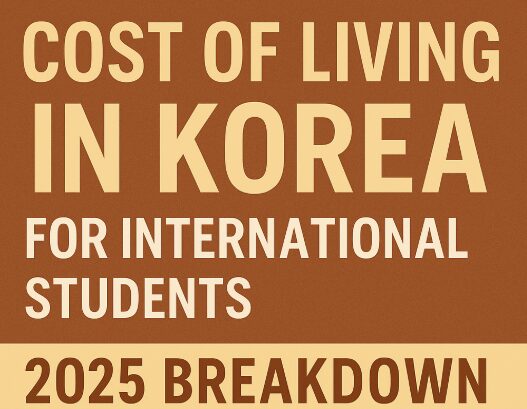Moving to South Korea for studies is an exciting step for thousands of international students each year. Whether you’re enrolling in a language program, pursuing an undergraduate degree, or completing your master’s, one of the first and most important things to understand is the cost of living.
South Korea, particularly Seoul, offers a dynamic student experience—cutting-edge technology, rich culture, and safety—but it’s also a place where living expenses can vary widely depending on your lifestyle, university location, and housing choices.
This guide provides a realistic, updated breakdown of the 2025 cost of living in Korea for international students, including housing, food, transportation, phone/internet, insurance, and more. It’s designed to help you budget effectively, whether you plan to live modestly or enjoy Korea’s bustling city life a little more comfortably.

Housing Costs
Housing is typically the largest monthly expense for students in Korea. Your choices include on-campus dormitories, Goshiwons (small private rooms), studio apartments (called officetels), or shared housing.
1. University Dormitories
Monthly cost: ₩300,000–₩800,000 (USD $225–$600)
Includes: Utilities, Wi-Fi, sometimes meals
Pros: Safe, affordable, close to campus
Cons: Curfews, shared bathrooms, limited privacy
Dorms are often the most budget-friendly option, especially in public universities. Spaces can be competitive, so early application is key.
2. Goshiwon (고시원)
Monthly cost: ₩250,000–₩550,000 (USD $190–$415)
Size: 4–7m², very compact
Includes: Private room, basic furniture, shared kitchen/bathroom
Goshiwons are tiny but popular among language students or short-term exchange students. Most provide free rice, kimchi, and noodles.
3. One-Room Apartment / Officetel
Monthly rent: ₩500,000–₩900,000 (USD $380–$690)
Deposit: ₩5,000,000–₩10,000,000 ($3,800–$7,700) is common
Additional fees: Utilities, maintenance, internet
Officetels offer full privacy and comfort but require a significant upfront deposit, which may be difficult for first-time renters. Monthly rent varies based on neighborhood, with Seoul and Busan being more expensive than cities like Daegu or Daejeon.
Food and Groceries
Food in Korea can be both affordable and convenient, especially with a mix of student cafeterias, convenience stores, and local restaurants.
University Cafeterias
Average meal: ₩3,000–₩5,000 ($2.30–$3.80)
Balanced Korean meals at budget-friendly prices, often subsidized for students.
Eating Out
Kimbap or basic meals: ₩4,000–₩7,000
Casual Korean restaurants: ₩6,000–₩12,000
Western meals / cafes: ₩10,000–₩18,000
Fast food combo: ₩6,500–₩9,000
You can comfortably eat out every day on a student budget, especially if you stick to Korean dishes. Cafes, on the other hand, can get pricey if visited frequently.
Groceries
Monthly grocery cost: ₩150,000–₩250,000 ($115–$190)
Items like meat, cheese, and foreign snacks are more expensive.
Big chain stores: E-Mart, Homeplus, Lotte Mart
Discount options: Daiso, local markets, Coupang (online)
Transportation
Public transportation in Korea is affordable, safe, and highly efficient.
Subway and Buses
Base fare per ride: ₩1,400–₩1,650 ($1.10–$1.30) with T-money card
Monthly pass (Seoul): ₩65,000–₩75,000 ($50–$58) for unlimited rides
T-money cards work across subways, buses, and even some taxis or convenience stores. Most students spend ₩50,000–₩80,000 per month on transportation.
Bicycles / Scooters
Kakao T Bike rental: ₩1,000 per 15 min
Universities like Korea University and Yonsei offer free or discounted bike rental for students.
Mobile Phone and Internet
Mobile Plans
Prepaid SIM: ₩30,000–₩50,000 ($23–$38) per month
Postpaid plan: ₩40,000–₩70,000 depending on data and provider
Providers: SK Telecom, KT, LG U+
Many students start with prepaid SIMs via companies like LG Hello Mobile or U-SIM Korea (especially during quarantine/arrival).
Internet
In dorms: Often included
Off-campus: ₩20,000–₩40,000 per month
Cafes and most public areas in Korea offer free high-speed Wi-Fi.
Health Insurance
As of recent policy changes, all international students in Korea are required to register for National Health Insurance (NHI) after 6 months of residence.
Monthly premium (2025): ₩50,000–₩60,000 ($38–$46)
Coverage includes doctor visits, hospital stays, dental care, and more.
Your university will typically help you register automatically. Before 6 months, private student insurance may be required.
Study Materials and Other Expenses
Books and Supplies
Textbooks: ₩100,000–₩200,000 per semester (especially for graduate students)
Stationery: ₩10,000–₩30,000 per month
Printing: ₩100 per page on campus (or cheaper with student card)
Entertainment and Social Life
Movie ticket: ₩13,000
Cafe drink: ₩5,000–₩8,000
Karaoke session: ₩10,000 per hour (split with friends)
Club entrance: ₩10,000–₩20,000 (some free for students on ladies’ nights)
Being social in Korea doesn’t have to break the bank. Many cultural events, K-pop festivals, and university activities are free or discounted for students.
Estimated Monthly Budget for International Students (2025)
| Category | Budget (₩) | Budget (USD) |
|---|---|---|
| Housing (Dormitory) | 400,000 | ~$300 |
| Food | 250,000 | ~$190 |
| Transportation | 60,000 | ~$45 |
| Phone + Internet | 50,000 | ~$38 |
| Insurance (NHI) | 55,000 | ~$42 |
| Misc (books, social) | 100,000 | ~$75 |
| Total (Monthly) | 915,000 | ~$690 |
For students living off-campus in a studio, total monthly costs may rise to ₩1.2M–₩1.5M (~$900–$1,150), especially in Seoul.
Living Smart in Korea: Cost-Saving Tips
Use student cafeterias instead of eating out daily
Join university clubs for free events and networking
Buy second-hand textbooks or use digital versions
Use discount apps like Yanolja (for lodging), Coupang Eats, or Naver Pay
Share housing with other students to cut rent
Take advantage of Korea’s banking offers for students (cashback, no-fee transfers)
Understanding Korea’s Student Living Costs Helps You Prepare with Confidence
Korea offers one of Asia’s most exciting study abroad experiences—but preparation is key. Knowing what to expect financially will help you avoid stress and make the most of your time abroad. Whether you’re on a tight budget or able to splurge a little, Korea has flexible options for every lifestyle.
By keeping your housing choices, dining habits, and spending under control, you can enjoy everything Korea has to offer—without sacrificing financial security. From late-night tteokbokki runs to cherry blossom picnics in spring, your study abroad journey can be rich, rewarding, and manageable—especially when you plan wisely.